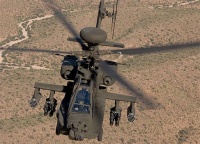Future aircraft, including UAVs, could integrate current and new technologies for sensing and reacting to airborne threats as part of a single system under development at the MoD’s Defence Science and Technology Laboratory (DSTL).
This would allow air forces to more easily upgrade existing vehicles with new technology and more easily reprogram such defensive aids systems (DAS) for different missions.

The system, referred to as a common defensive aids systems (CDAS), would also mean the MoD would be able to more fully exploit competition in the defence market because technologies built by different contractors could be used together.
‘While we would hope this new architecture would go into any new platform coming along, the essential feature of this design is that it is totally compatible with existing platforms,’ DSTL’s principal engineer on the project, Peter Haynes, told The Engineer.
‘By putting in the CDAS spine concept you can then introduce new functionality very flexibly, but we don’t need to rip out all the wiring and all the infrastructure of the existing subsystems.’
Integrating different systems would also enable the MoD to configure aircraft for specific missions without having to make major changes to the architecture, said Dr Jim Wickes, who is responsible for aircraft survivability at DSTL.
‘The aircraft we’re currently flying with are going to be around for a long time and we’ll be introducing new ones. If you’re putting an existing platform into theatre with a new one you have a real problem if their capability is fundamentally different. That gives the frontline commander a real headache about which assets to use.
‘This allows us to upgrade our existing legacy platforms in line with the capability upgrades we need. It’s not a big, sudden revolution because that’s impractical and unaffordable. It’s an evolution from legacy to the future.’
After 18 months of studies and a further 18 months of hardware development, DSTL has now put together a technology demonstrator programme (TDP) in partnership with four defence firms, showing how different sensors and countermeasures can work together under one DAS controller.
The TDP includes a current missile warning system built by BAE North America, a new infrared threat-warning system being developed by Thales, a developmental system for detecting hostile gunfire from the ground and a laser warning system, all feeding into the DAS controller.
On the output side of the demonstrator system is a next-generation laser countermeasure built by Selex. Other countermeasures could include chaff (tiny pieces of material to confuse radar systems) or flares. A Qinetiq on-board planning system has also been integrated into the TDP.
The challenge now would be to open the system to other existing proprietary technologies, said Haynes. ‘It’s getting the current system alongside the new systems to supply essentially the same threat message so that it makes no difference [which is] plugged in.’
Other advantages of the CDAS include its ability to record information from all the sensors and transmit it to other vehicles or back to base for mission planning or use in post-mission analysis or training.
The system is also designed with an eye on exports. Elements that the MoD wants to keep solely for the UK military are built as additional options, meaning the basic structure of the system can be sold abroad.
DSTL plans to conduct flight trials of the technology by the end of December, after which it will be up to the Defence Equipment and Support (DE&S) department to decide how the system will be manufactured and rolled out across the UK’s air fleet.
The CDAS system evolved from the Helicopter Integrated DAS, which was used on UK Apaches from 2000 but wasn’t designed to integrate new components.




Project to investigate hybrid approach to titanium manufacturing
What is this a hybrid of? Superplastic forming tends to be performed slowly as otherwise the behaviour is the hot creep that typifies hot...